Quantifying Sediment Deposition Volume in Vegetated Areas with UAV Data
Abstract
1. Introduction
2. Study Area
3. Methodology
3.1. Field Data Acquisition
3.2. Remotely Sensed Data
| Data | Time of Acquisition | Resolution (m) | Vertical Accuracy (m) | Source |
|---|---|---|---|---|
| SRTM DTM | February 2000 | 30 | ≈ 9.00 | US National Aeronautics and Space Administration |
| ALOS PALSAR DTM | March 2011 | 12.5 | ≈ 5.00 | Japan Aerospace Exploration Agency |
| UAV pre-event DSM and orthophotos | 22 August to 3 September 2017 | 0.02 | 0.10 | University of Portsmouth [67,68] |
| UAV post-event DSM and orthophotos | 25 January to 2 February 2018 | 0.04 | 0.10 | University of Portsmouth [68] |
| LiDAR post-event DSM and DTM | 19 February to 5 May 2018 | 0.50 | 0.05 | Dominica’s National Physical Planning Department [69] |
3.3. Deposition Height Estimation
- UAV-DSM-DoD was converted to points and spatially interpolated with Gaussian Kriging to cover the whole study area. Kriging produces unbiased values with minimum variance [71], and it is based on regionalized variable theory (RVT) which is capable of describing the variation in sediment accumulation [36]. Four Kriging models (Exponential, Circular, Spherical, and Gaussian) were applied and compared. The Gaussian model was used as it provided the best semivariogram fit. The masked-out parts were filled in using the corresponding parts of the interpolated raster.
3.4. Verification
3.4.1. Field Measurements
3.4.2. Volume of Removed Sediments
3.4.3. Trend Surfaces
4. Results
4.1. Deposition Height Estimation
4.2. Verification
4.2.1. Field Measurements
4.2.2. Sediment Removal
4.2.3. Trend Surface Analysis
5. Discussion
6. Conclusions
Author Contributions
Funding
Institutional Review Board Statement
Informed Consent Statement
Data Availability Statement
Acknowledgments
Conflicts of Interest
References
- Vos, F.; Rodríguez, J.; Below, R.; Guha-Sapir, D. Annual Disaster Statistical Review 2009: The Numbers and Trends; Centre for Research on the Epidemiology of Disasters (CRED): Brussels, Belgium, 2010. [Google Scholar]
- Guha-Sapir, D. EM-DAT: The Emergency Events Database; Universite catholique de Louvain (UCL)—CRED: Brussels, Belgium, 2017. [Google Scholar]
- Islam, M.M.; Sado, K. Development of flood hazard maps of Bangladesh using NOAA-AVHRR images with GIS. Hydrol. Sci. J. 2000, 45, 337–355. [Google Scholar] [CrossRef]
- Freni, G.; La Loggia, G.; Notaro, V. Uncertainty in urban flood damage assessment due to urban drainage modelling and depth-damage curve estimation. Water Sci. Technol. 2010, 61, 2979–2993. [Google Scholar] [CrossRef] [PubMed]
- Kourgialas, N.N.; Karatzas, G.P. Flood management and a GIS modelling method to assess flood-hazard areas—A case study. Hydrol. Sci. J. 2011, 56, 212–225. [Google Scholar] [CrossRef]
- Alfieri, L.; Salamon, P.; Bianchi, A.; Neal, J.; Bates, P.; Feyen, L. Advances in pan-European flood hazard mapping. Hydrol. Process. 2014, 28, 4067–4077. [Google Scholar] [CrossRef]
- Tsakiris, G. Flood risk assessment: Concepts, modelling, applications. Nat. Hazards Earth Syst. Sci. 2014, 14, 1361–1369. [Google Scholar] [CrossRef]
- Kelman, I. Physical Flood Vulnerability of Residential Properties in Coastal, Eastern England. Ph.D. Thesis, University of Cambridge, Cambridge, UK, 2003. [Google Scholar]
- Merz, B.; Kreibich, H.; Thieken, A.; Schmidtke, R. Estimation uncertainty of direct monetary flood damage to buildings. Nat. Hazards Earth Syst. Sci. 2004, 4, 153–163. [Google Scholar] [CrossRef]
- Nascimento, N.; Baptista, M.; Silva, A.; Léa Machado, M.; de Lima, J.C.; Gonçalves, M.; Dias, R.; Machado, É. Flood-damage curves: Methodological development for the Brazilian context. Water Pract. Technol. 2006, 1, wpt2006022. [Google Scholar] [CrossRef]
- Notaro, V.; De Marchis, M.; Fontanazza, C.; La Loggia, G.; Puleo, V.; Freni, G. The effect of damage functions on urban flood damage appraisal. Procedia Eng. 2014, 70, 1251–1260. [Google Scholar] [CrossRef]
- Huizinga, J.; de Moel, H.; Szewczyk, W. Global Flood Depth-Damage Functions: Methodology and the Database With Guidelines; Joint Research Centre (Seville Site): Brussels, Belgium, 2017. [Google Scholar]
- Scorzini, A.; Frank, E. Flood damage curves: New insights from the 2010 flood in Veneto, Italy. J. Flood Risk Manag. 2017, 10, 381–392. [Google Scholar] [CrossRef]
- Jetten, V.; Favis-Mortlock, D. Modelling soil erosion in Europe. Soil Eros. Eur. 2006, 66, 695–716. [Google Scholar]
- Tibebe, D.; Bewket, W. Surface runoff and soil erosion estimation using the SWAT model in the Keleta watershed, Ethiopia. Land Degrad. Dev. 2011, 22, 551–564. [Google Scholar] [CrossRef]
- Prasannakumar, V.; Vijith, H.; Abinod, S.; Geetha, N. Estimation of soil erosion risk within a small mountainous sub-watershed in Kerala, India, using Revised Universal Soil Loss Equation (RUSLE) and geo-information technology. Geosci. Front. 2012, 3, 209–215. [Google Scholar] [CrossRef]
- Ochoa-Cueva, P.; Fries, A.; Montesinos, P.; Rodríguez-Díaz, J.A.; Boll, J. Spatial estimation of soil erosion risk by land-cover change in the Andes of southern Ecuador. Land Degrad. Dev. 2015, 26, 565–573. [Google Scholar] [CrossRef]
- Nearing, M.; Lane, L.J.; Lopes, V.L. Modeling soil erosion. In Soil Erosion Research Methods; Routledge: Oxfordshire, UK, 2017; pp. 127–158. [Google Scholar]
- Boardman, J.; Evans, R.; Ford, J. Muddy floods on the South Downs, southern England: Problem and responses. Environ. Sci. Policy 2003, 6, 69–83. [Google Scholar] [CrossRef]
- Merz, B.; Kreibich, H.; Schwarze, R.; Thieken, A. Review article: Assessment of economic flood damage. Nat. Hazards Earth Syst. Sci. 2010, 10, 1697. [Google Scholar] [CrossRef]
- Bohner, A.; Winter, S.; Kraml, B.; Holzner, W. Destructive and constructive effects of mudflows–primary succession and success of pasture regeneration in the nature park Sölktäler (Styria, Austria). In Proceedings of the 5th Symposium for Research in Protected Areas, Mittersill, Austria, 10–12 June 2013; pp. 71–74. [Google Scholar]
- Kim, H.Y.; Julien, P.Y. Hydraulic Thresholds to Mitigate Sedimentation Problems at Sangju Weir, South Korea. J. Hydraul. Eng. 2018, 144, 05018005. [Google Scholar] [CrossRef]
- Hürlimann, M.; Copons, R.; Altimir, J. Detailed debris flow hazard assessment in Andorra: A multidisciplinary approach. Geomorphology 2006, 78, 359–372. [Google Scholar] [CrossRef]
- Calvo, B.; Savi, F. A real-world application of Monte Carlo procedure for debris flow risk assessment. Comput. Geosci. 2009, 35, 967–977. [Google Scholar] [CrossRef]
- Quan Luna, B.; Blahut, J.; Van Westen, C.; Sterlacchini, C.; van Asch, T.W.; Akbas, S. The application of numerical debris flow of modelling for the generation physical vulnerability curves. Nat. Hazards Earth Syst. Sci. 2011, 11, 2047–2060. [Google Scholar] [CrossRef]
- Du, J.; Yin, K.; Nadim, F.; Lacasse, S. Quantitative vulnerability estimation for individual landslides. In Proceedings of the 18th International Conference on Soil Mechanics and Geotechnical Engineering, Paris, France, 2–6 September 2013; pp. 2181–2184. [Google Scholar]
- Chen, C.-Y.; Yu, F.-C. Morphometric analysis of debris flows and their source areas using GIS. Geomorphology 2011, 129, 387–397. [Google Scholar] [CrossRef]
- Huang, C.-h.; Wells, L.; Norton, L. Sediment transport capacity and erosion processes: Model concepts and reality. Earth Surf. Process. Landf. J. Br. Geomorphol. Res. Group 1999, 24, 503–516. [Google Scholar] [CrossRef]
- Victor, S.; Neth, L.; Golbuu, Y.; Wolanski, E.; Richmond, R.H. Sedimentation in mangroves and coral reefs in a wet tropical island, Pohnpei, Micronesia. Estuar. Coast. Shelf Sci. 2006, 66, 409–416. [Google Scholar] [CrossRef]
- Van Santen, P.; Augustinus, P.; Janssen-Stelder, B.; Quartel, S.; Tri, N. Sedimentation in an estuarine mangrove system. J. Asian Earth Sci. 2007, 29, 566–575. [Google Scholar] [CrossRef]
- Kulkarni, U.; Khan, A.; Gavali, R. Rate of siltation in Wular Lake, (Jammu and Kashmir, India) with special emphasis on its climate & tectonics. Int. J. Clim. Chang. Impacts Responses 2009, 1, 233–244. [Google Scholar]
- Fuchs, S.; Heiss, K.; Hübl, J. Towards an empirical vulnerability function for use in debris flow risk assessment. Nat. Hazards Earth Syst. Sci. 2007, 7, 495–506. [Google Scholar] [CrossRef]
- Totschnig, R.; Sedlacek, W.; Fuchs, S. A quantitative vulnerability function for fluvial sediment transport. Nat. Hazards 2011, 58, 681–703. [Google Scholar] [CrossRef]
- Cánovas, J.B.; Stoffel, M.; Corona, C.; Schraml, K.; Gobiet, A.; Tani, S.; Sinabell, F.; Fuchs, S.; Kaitna, R. Debris-flow risk analysis in a managed torrent based on a stochastic life-cycle performance. Sci. Total Environ. 2016, 557, 142–153. [Google Scholar] [CrossRef] [PubMed]
- Breien, H.; De Blasio, F.V.; Elverhøi, A.; Høeg, K. Erosion and morphology of a debris flow caused by a glacial lake outburst flood, Western Norway. Landslides 2008, 5, 271–280. [Google Scholar] [CrossRef]
- Asselman, N.E.; Middelkoop, H. Floodplain sedimentation: Quantities, patterns and processes. Earth Surf. Process. Landf. 1995, 20, 481–499. [Google Scholar] [CrossRef]
- Nakatani, K.; Kosugi, M.; Satofuka, Y.; Mizutama, T. Debris flow flooding and debris deposition considering the effect of houses: Disaster verification and numerical simulation. Int. J. Eros. Control Eng. 2016, 9, 145–154. [Google Scholar] [CrossRef][Green Version]
- Hänsel, P.; Kaiser, A.; Buchholz, A.; Böttcher, F.; Langel, S.; Schmidt, J.; Schindewolf, M. Mud flow reconstruction by means of physical erosion modeling, high-resolution radar-based precipitation data, and UAV monitoring. Geosciences 2018, 8, 427. [Google Scholar] [CrossRef]
- Lane, S.N.; Westaway, R.M.; Murray Hicks, D. Estimation of erosion and deposition volumes in a large, gravel-bed, braided river using synoptic remote sensing. Earth Surf. Process. Landf. J. Br. Geomorphol. Res. Group 2003, 28, 249–271. [Google Scholar] [CrossRef]
- Milan, D.J.; Heritage, G.L.; Hetherington, D. Application of a 3D laser scanner in the assessment of erosion and deposition volumes and channel change in a proglacial river. Earth Surf. Process. Landf. J. Br. Geomorphol. Res. Group 2007, 32, 1657–1674. [Google Scholar] [CrossRef]
- Entwistle, N.; Heritage, G.; Milan, D. Recent remote sensing applications for hydro and morphodynamic monitoring and modelling. Earth Surf. Process. Landf. 2018, 43, 2283–2291. [Google Scholar] [CrossRef]
- Webster, T.; Templin, A.; Ferguson, M.; Dickie, G. Remote predictive mapping of aggregate deposits using lidar. Can. J. Remote Sens. 2009, 35, S154–S166. [Google Scholar] [CrossRef]
- Bull, J.; Miller, H.; Gravley, D.; Costello, D.; Hikuroa, D.; Dix, J. Assessing debris flows using LIDAR differencing: 18 May 2005 Matata event, New Zealand. Geomorphology 2010, 124, 75–84. [Google Scholar] [CrossRef]
- Tang, C.; Tanyas, H.; van Westen, C.J.; Tang, C.; Fan, X.; Jetten, V.G. Analysing post-earthquake mass movement volume dynamics with multi-source DEMs. Eng. Geol. 2019, 248, 89–101. [Google Scholar] [CrossRef]
- Milan, D.J. Geomorphic impact and system recovery following an extreme flood in an upland stream: Thinhope Burn, northern England, UK. Geomorphology 2012, 138, 319–328. [Google Scholar] [CrossRef]
- Milan, D.; Heritage, G.; Tooth, S.; Entwistle, N. Morphodynamics of bedrock-influenced dryland rivers during extreme floods: Insights from the Kruger National Park, South Africa. GSA Bull. 2018, 130, 1825–1841. [Google Scholar] [CrossRef]
- Hayes, J.L.; Wilson, T.M.; Magill, C. Tephra fall clean-up in urban environments. J. Volcanol. Geotherm. Res. 2015, 304, 359–377. [Google Scholar] [CrossRef]
- Brasington, J.; Langham, J.; Rumsby, B. Methodological sensitivity of morphometric estimates of coarse fluvial sediment transport. Geomorphology 2003, 53, 299–316. [Google Scholar] [CrossRef]
- Fuller, I.C.; Large, A.R.; Charlton, M.E.; Heritage, G.L.; Milan, D.J. Reach-scale sediment transfers: An evaluation of two morphological budgeting approaches. Earth Surf. Process. Landf. J. Br. Geomorphol. Res. Group 2003, 28, 889–903. [Google Scholar] [CrossRef]
- Heritage, G.L.; Milan, D.J.; Large, A.R.; Fuller, I.C. Influence of survey strategy and interpolation model on DEM quality. Geomorphology 2009, 112, 334–344. [Google Scholar] [CrossRef]
- Wheaton, J.M.; Brasington, J.; Darby, S.E.; Sear, D.A. Accounting for uncertainty in DEMs from repeat topographic surveys: Improved sediment budgets. Earth Surf. Process. Landf. J. Br. Geomorphol. Res. Group 2010, 35, 136–156. [Google Scholar] [CrossRef]
- Milan, D.J.; Heritage, G.L.; Large, A.R.; Fuller, I.C. Filtering spatial error from DEMs: Implications for morphological change estimation. Geomorphology 2011, 125, 160–171. [Google Scholar] [CrossRef]
- Malhotra, A.; Thorpe, R.S.; Hypolite, E.; James, A. A report on the status of the herpetofauna of the Commonwealth of Dominica, West Indies. Appl. Herpetol. 2007, 4, 177–194. [Google Scholar]
- Steiner, S.C.C. Stony corals and reefs of Dominica. Atoll Res. Bull. 2003, 498, 1–15. [Google Scholar] [CrossRef][Green Version]
- Talbot-Wendlandt, H. Composition And Short-Timescale Erosion Patterns Of River Sediments On Dominica. Keck Geol. Consort. 2018, 31, 31. [Google Scholar]
- Knutson, T.R.; Sirutis, J.J.; Zhao, M.; Tuleya, R.E.; Bender, M.; Vecchi, G.A.; Villarini, G.; Chavas, D. Global projections of intense tropical cyclone activity for the late twenty-first century from dynamical downscaling of CMIP5/RCP4. 5 scenarios. J. Clim. 2015, 28, 7203–7224. [Google Scholar] [CrossRef]
- YIFRU, J. National Scale Landslide Hazard Assessment along the Road Corridors of Dominica and Saint Lucia. Master’s Thesis, ITC, University of Twente, Enschede, The Netherlands, 2015. Available online: http://www.itc.nl/library/papers_2015/msc/aes/yifru.pdf (accessed on 3 May 2021).
- Williams, A.N. Towards a Deeper Understanding of the Caribbean Water Supply Crisis; Caribbean Water Transshipment Company Ltd.: Dominica, 2016; Available online: https://d1wqtxts1xzle7.cloudfront.net/44428169/Understanding_the_Water_Crisis_in_the_Eastern_Caribbean-with-cover-page-v2.pdf?Expires=1624247205&Signature=H6xYSDo1xjeTqOXuAjpvHcoKqW42R0Hc8Vld2agmtrExg332ao5tPQgrEe~YvtDxWPSJyPOMdP8UESuU7luYE9P4qU~LB8GJYH-BoSyYxmrtCAaIU7z1uyAgx70fiHUhFJ4NNZm1mkx~zHuM--3Bfigk3d8PRabgBGHX9gScHMiJQUVCeT2COJEO7XWz5HU0EISLQhET0sEnImdLvnwPEbEsIw0BXVTCnoP3rE2W3zCseO-Hxcv8rhAYzJwP~nEVLBw0ay0o2MzqyGksauokDnBmBQ5GHT~CaJadNSXINmndRuXWXufkFPNoSMtdNcyJsYdpmQCsIzHz6lIS-lWEng__&Key-Pair-Id=APKAJLOHF5GGSLRBV4ZA (accessed on 15 June 2021).
- US Army Corps of Engineers. Water Resources Assessment of Dominica, Antigua, Barbuda, St. Kitts and Nevis; US Army Corps of Engineers: Norfolk, VA, USA, 2004. [Google Scholar]
- Government of the Commonwealth of Dominica. Climate Data. Available online: https://www.weather.gov.dm/climate/climate-data (accessed on 5 May 2021).
- Van Westen, C.; Zhang, J. Tropical Cyclone Maria. Inventory of Landslides and Flooded Areas UNITAR Map Product ID 2018, 2762. Available online: https://unitar.org/maps/map/2762 (accessed on 5 May 2021).
- Government of the Commonwealth of Dominica. Post-Disaster Needs Assessment Hurricane Maria September 18, 2017; Government of the Commonwealth of Dominica: Roseau, Dominica, 2017. Available online: https://reliefweb.int/sites/reliefweb.int/files/resources/dominica-pdna-maria.pdf (accessed on 5 May 2021).
- Heidarzadeh, M.; Teeuw, R.; Day, S.; Solana, C. Storm wave runups and sea level variations for the September 2017 Hurricane Maria along the coast of Dominica, eastern Caribbean sea: Evidence from field surveys and sea-level data analysis. Coast. Eng. J. 2018, 60, 371–384. [Google Scholar] [CrossRef]
- UK Research and Innovation. Hurricane Maria and Dominica: Geomorphological Change and Infrastructure Damage Baseline Surveys, with Verification af Mapping From Satellite Imagery. Available online: https://gtr.ukri.org/projects?ref=NE%2FR016968%2F1 (accessed on 5 May 2021).
- Commonwealth of Dominica. Managementof Post-Hurricane Disaster Waste; Government of the Commonwealth of Dominica: Roseau, Dominica, 2017; p. 62.
- Inserra, D.; Bogie, J.; Katz, D.; Furth, S.; Burke, M.; Tubb, K.; Loris, N.D.; Bucci, S.P. After the Storms: Lessons from Hurricane Response and Recovery in 2017; Heritage Foundation: Washington, DC, USA, 2018. [Google Scholar]
- Zekkos, D.; Manousakis, J.; Clark, M. Digital Surface Model Creation of Select Floodplains in Dominica; University of Michigan: Ann Arbor, MI, USA, 2018. [Google Scholar]
- Schaefer, M.; Teeuw, R.; Day, S.; Zekkos, D.; Weber, P.; Meredith, T.; Van Westen, C.J. Low-cost UAV surveys of hurricane damage in Dominica: Automated processing with co-registration of pre-hurricane imagery for change analysis. Nat. Hazards 2020, 101, 755–784. [Google Scholar] [CrossRef]
- McElhanney Consulting Services Ltd. Light Detection and Ranging (LiDAR) Bathymetry and Topography Survey, Data Analysis, Modeling and Development of High Accuracy Terrain and Bathymetric Models; McElhanney Consulting Services Ltd.: Vancouver, BC, Canada, 2018; p. 42. [Google Scholar]
- Fewtrell, T.; Bates, P.D.; Horritt, M.; Hunter, N. Evaluating the effect of scale in flood inundation modelling in urban environments. Hydrol. Process. Int. J. 2008, 22, 5107–5118. [Google Scholar] [CrossRef]
- Burgess, T.; Webster, R. Optimal interpolation and isarithmic mapping of soil properties: I the semi-variogram and punctual kriging. J. Soil Sci. 1980, 31, 315–331. [Google Scholar] [CrossRef]
- Wesselung, C.G.; Karssenberg, D.J.; Burrough, P.A.; van Deursen, W.P. Integrating dynamic environmental models in GIS: The development of a Dynamic Modelling language. Trans. GIS 1996, 1, 40–48. [Google Scholar] [CrossRef]
- Karssenberg, D.; Schmitz, O.; Salamon, P.; de Jong, K.; Bierkens, M.F. A software framework for construction of process-based stochastic spatio-temporal models and data assimilation. Environ. Model. Softw. 2010, 25, 489–502. [Google Scholar] [CrossRef]
- Esri. How Trend Works. Available online: https://desktop.arcgis.com/en/arcmap/10.3/tools/spatial-analyst-toolbox/how-trend-works.htm (accessed on 5 May 2021).
- Pierson, T.C.; Costa, J.E.; Vancouver, W. A rheologic classification of subaerial sediment-water flows. Rev. Eng. Geol. 1987, 7, 1–12. [Google Scholar]
- Martinsen, O. Mass Movements. In The Geological Deformation of Sediments; Springer: Berlin/Heidelberg, Germany, 1994; pp. 127–165. [Google Scholar]
- Lenzi, M.A.; Marchi, L. Suspended sediment load during floods in a small stream of the Dolomites (northeastern Italy). Catena 2000, 39, 267–282. [Google Scholar] [CrossRef]
- Theule, J.; Liébault, F.; Loye, A.; Laigle, D.; Jaboyedoff, M. Sediment budget monitoring of debris-flow and bedload transport in the Manival Torrent, SE France. Nat. Hazards Earth Syst. Sci. 2012, 12, 731–749. [Google Scholar] [CrossRef]
- Arun, P.V. A comparative analysis of different DEM interpolation methods. Egypt. J. Remote Sens. Space Sci. 2013, 16, 133–139. [Google Scholar]
- Scheidl, C.; Rickenmann, D. Empirical prediction of debris-flow mobility and deposition on fans. Earth Surf. Process. Landf. J. Br. Geomorphol. Res. Group 2010, 35, 157–173. [Google Scholar] [CrossRef]
- Ozturk, U.; Wendi, D.; Crisologo, I.; Riemer, A.; Agarwal, A.; Vogel, K.; López-Tarazón, J.A.; Korup, O. Rare flash floods and debris flows in southern Germany. Sci. Total Environ. 2018, 626, 941–952. [Google Scholar] [CrossRef] [PubMed]
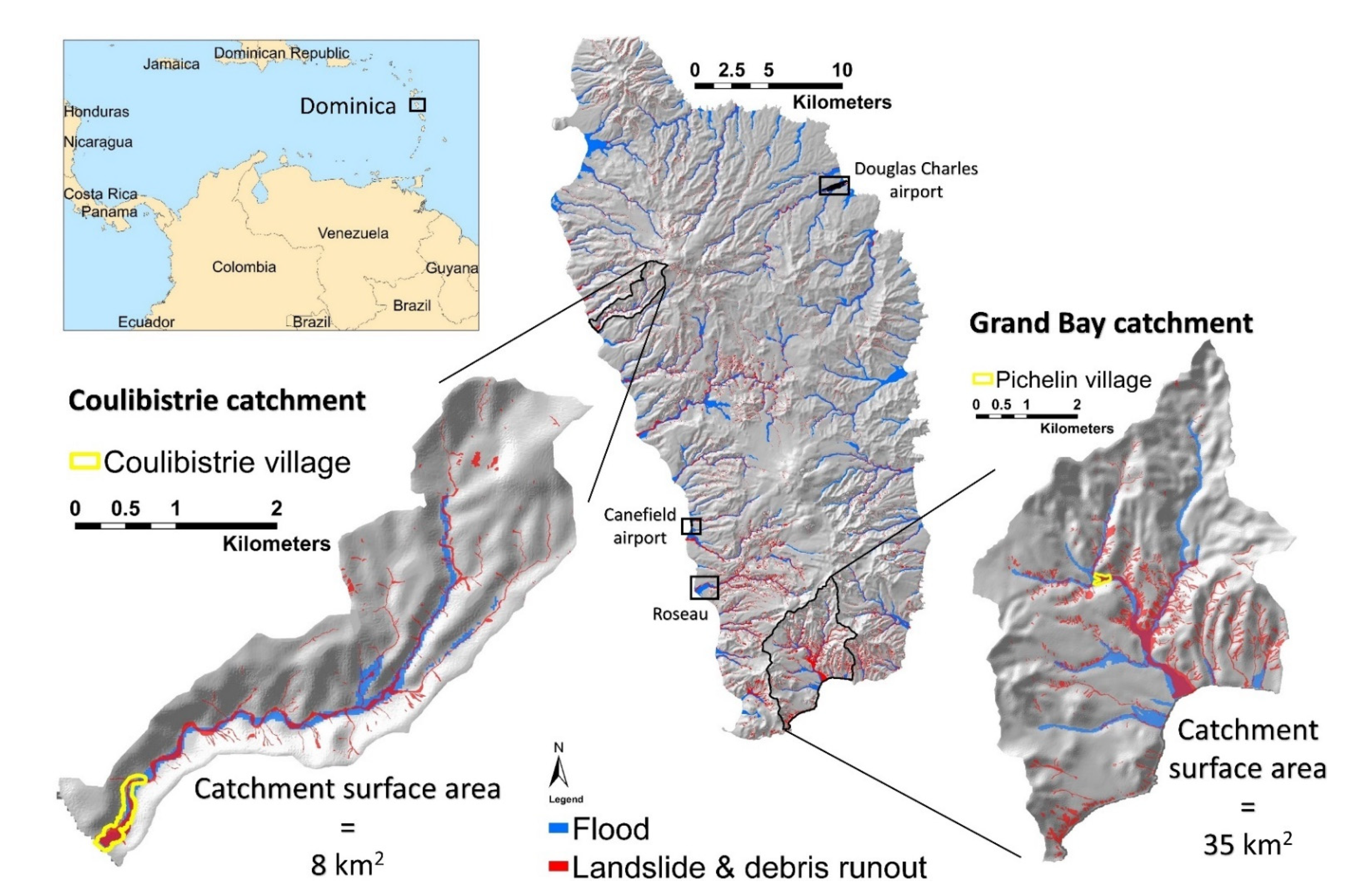
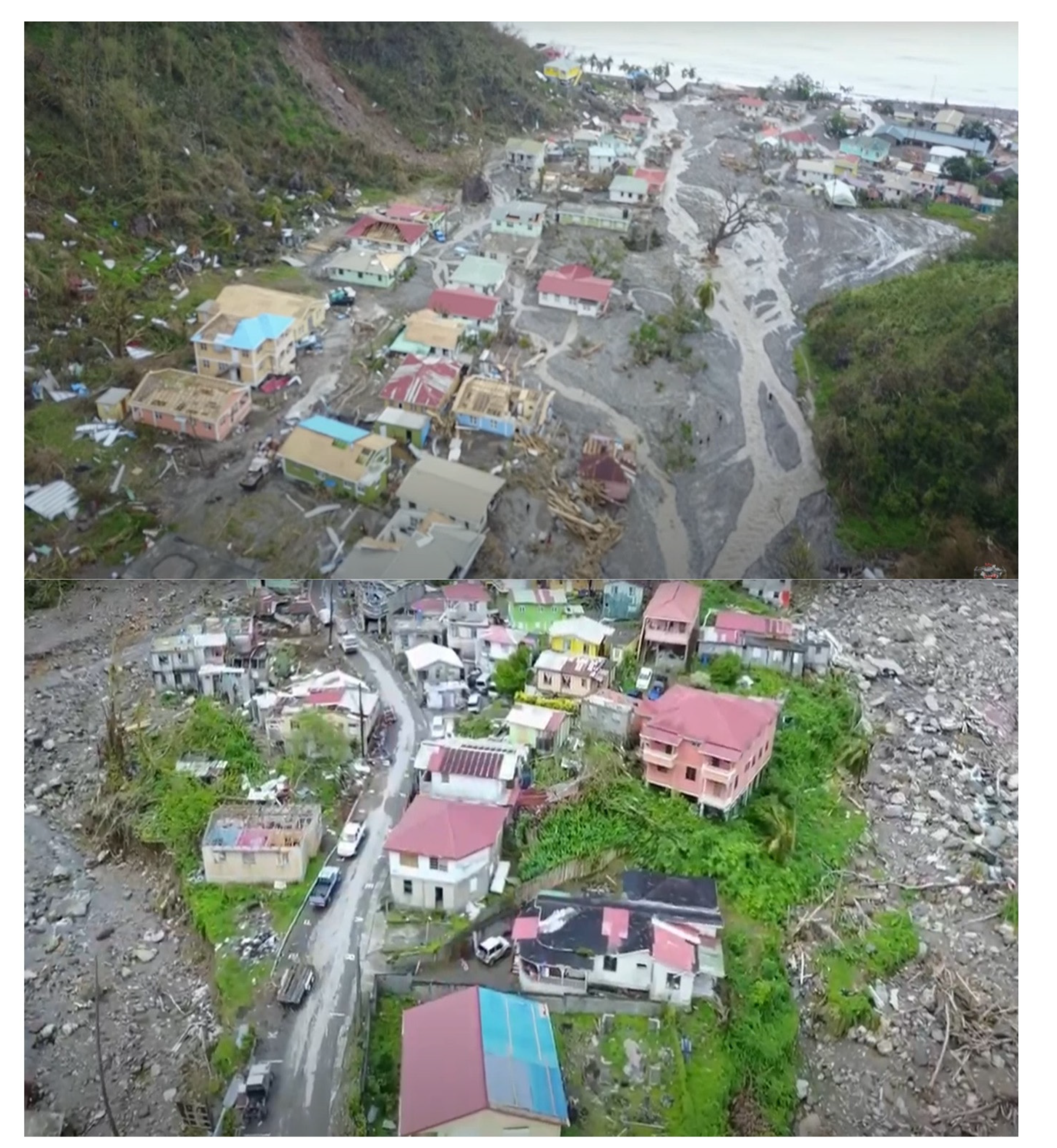
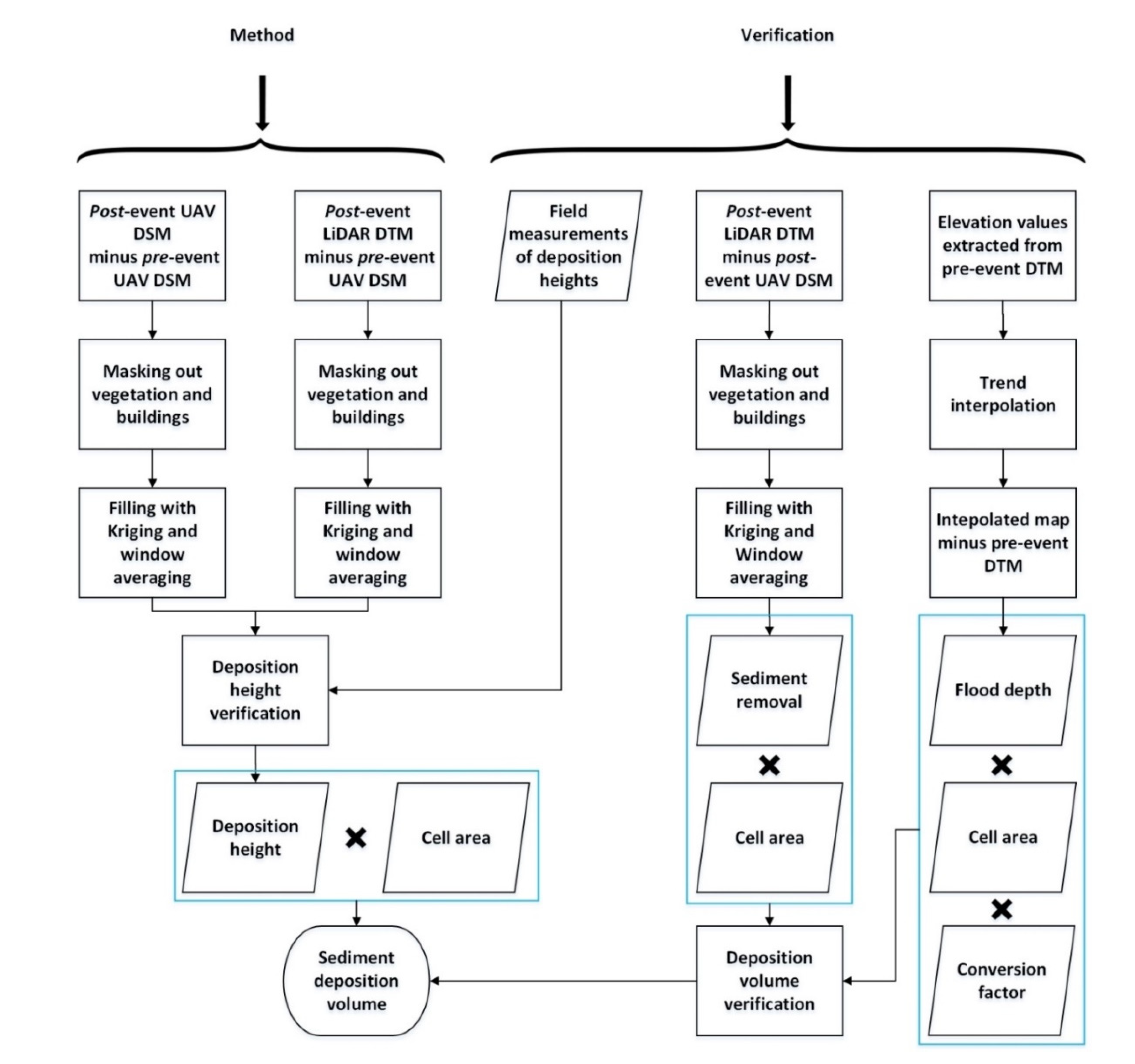

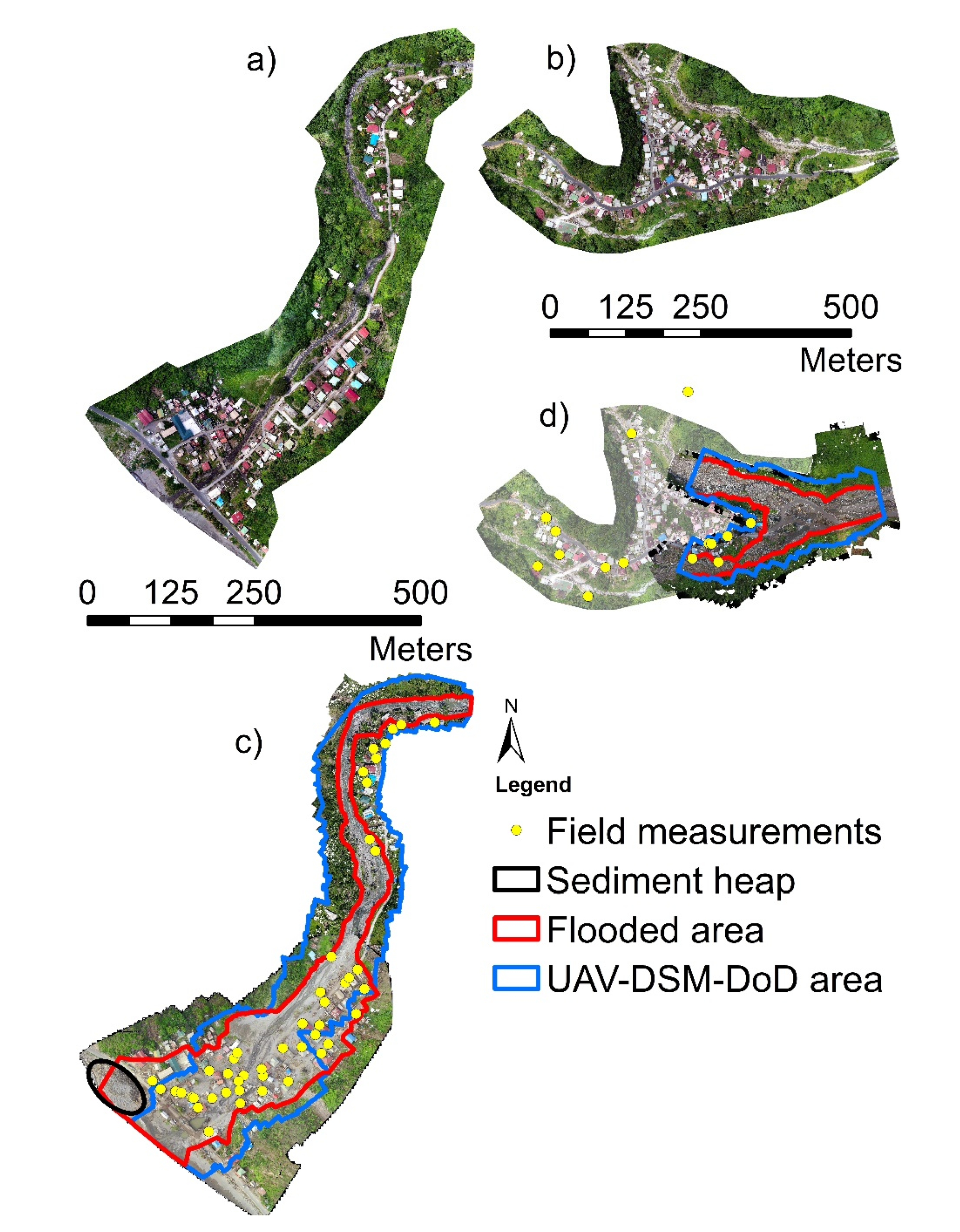
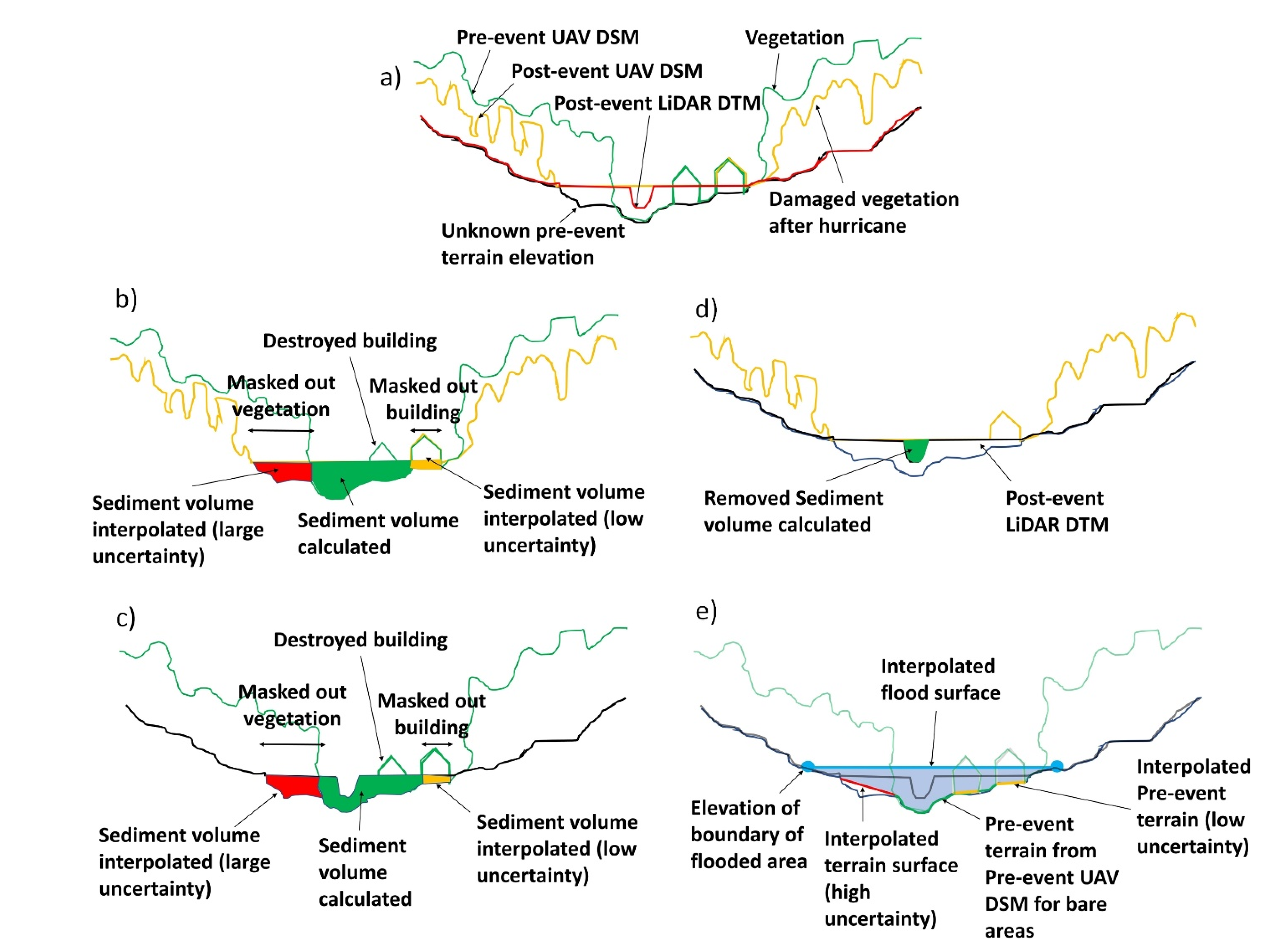
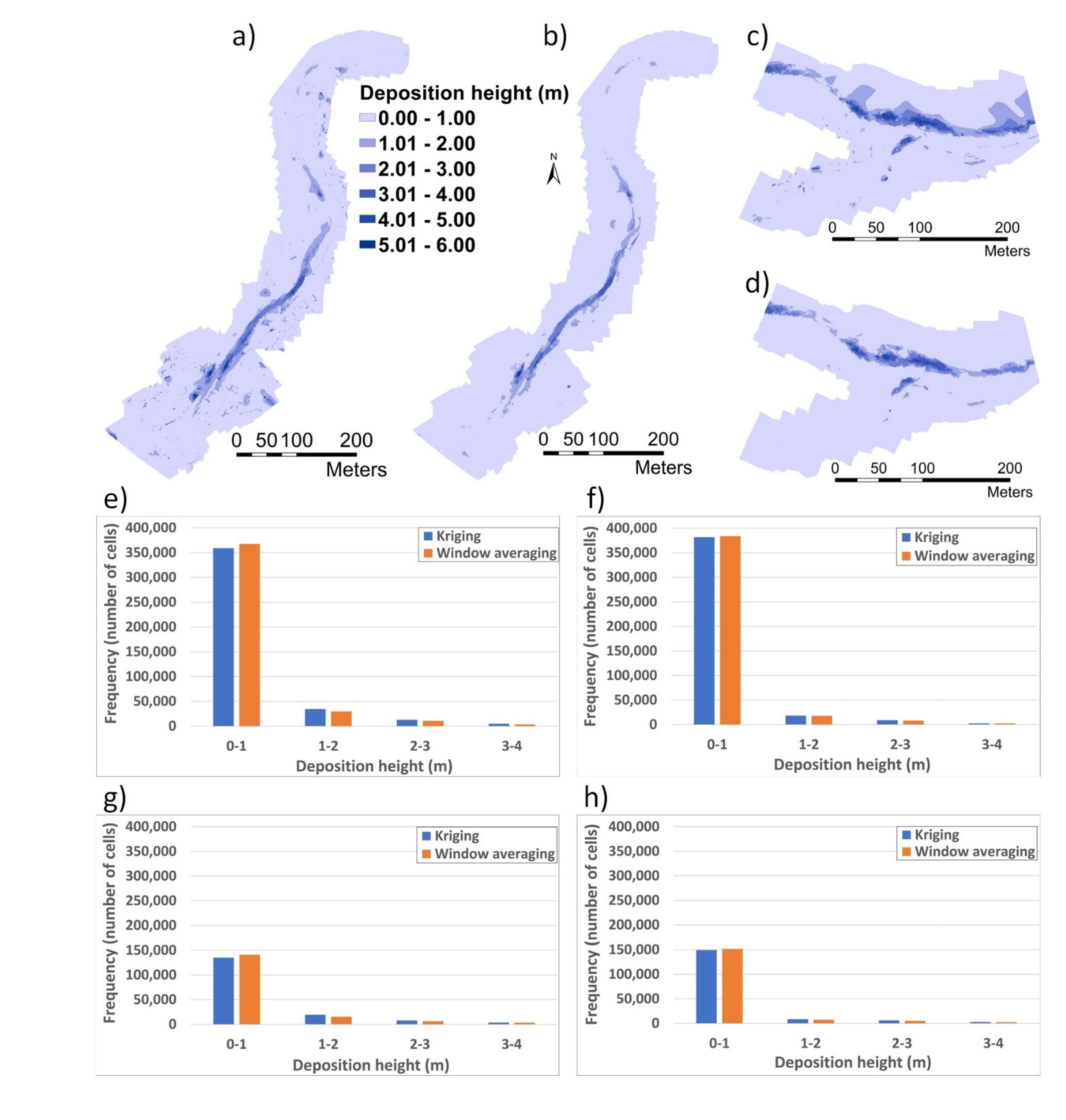


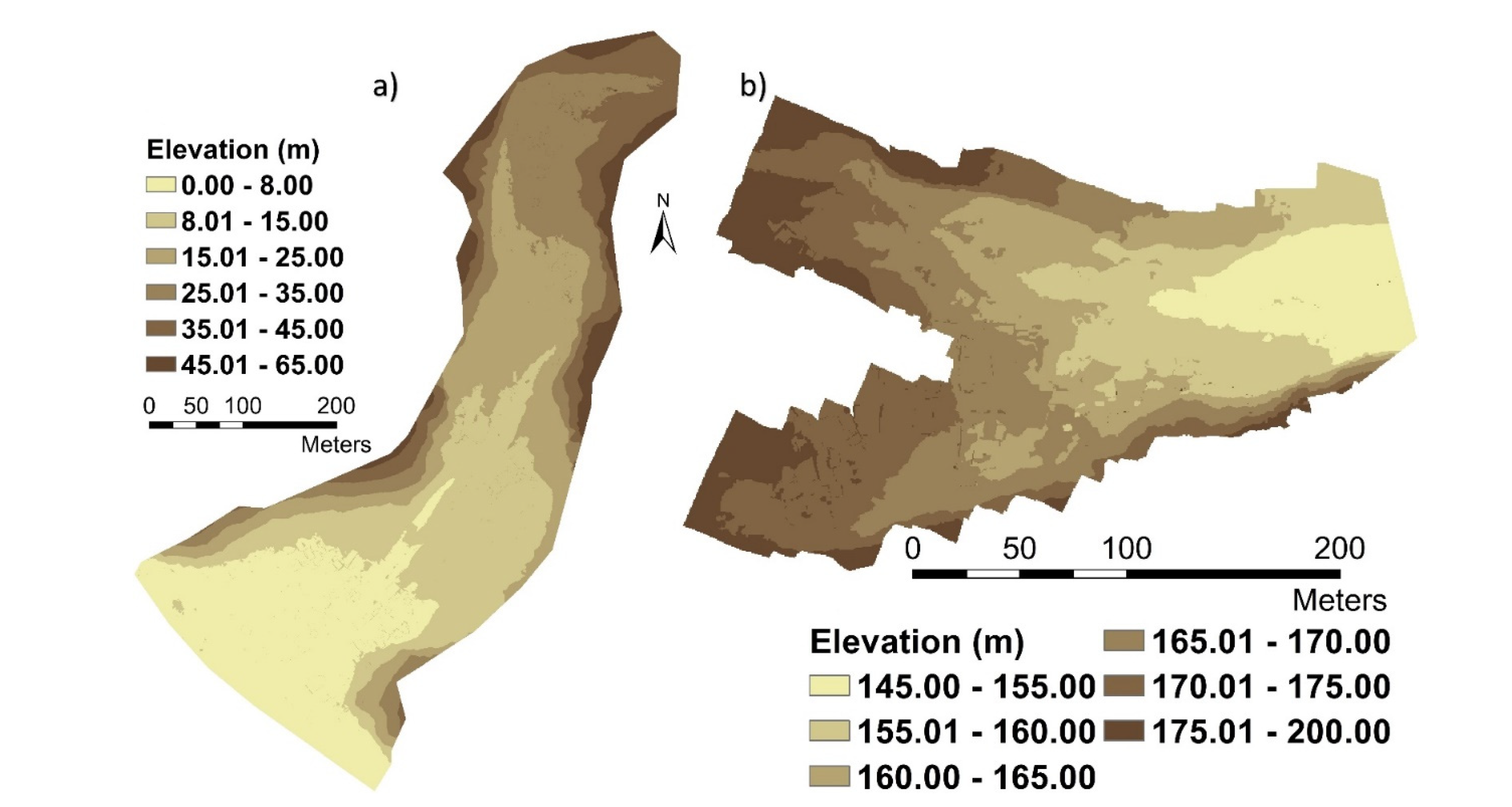
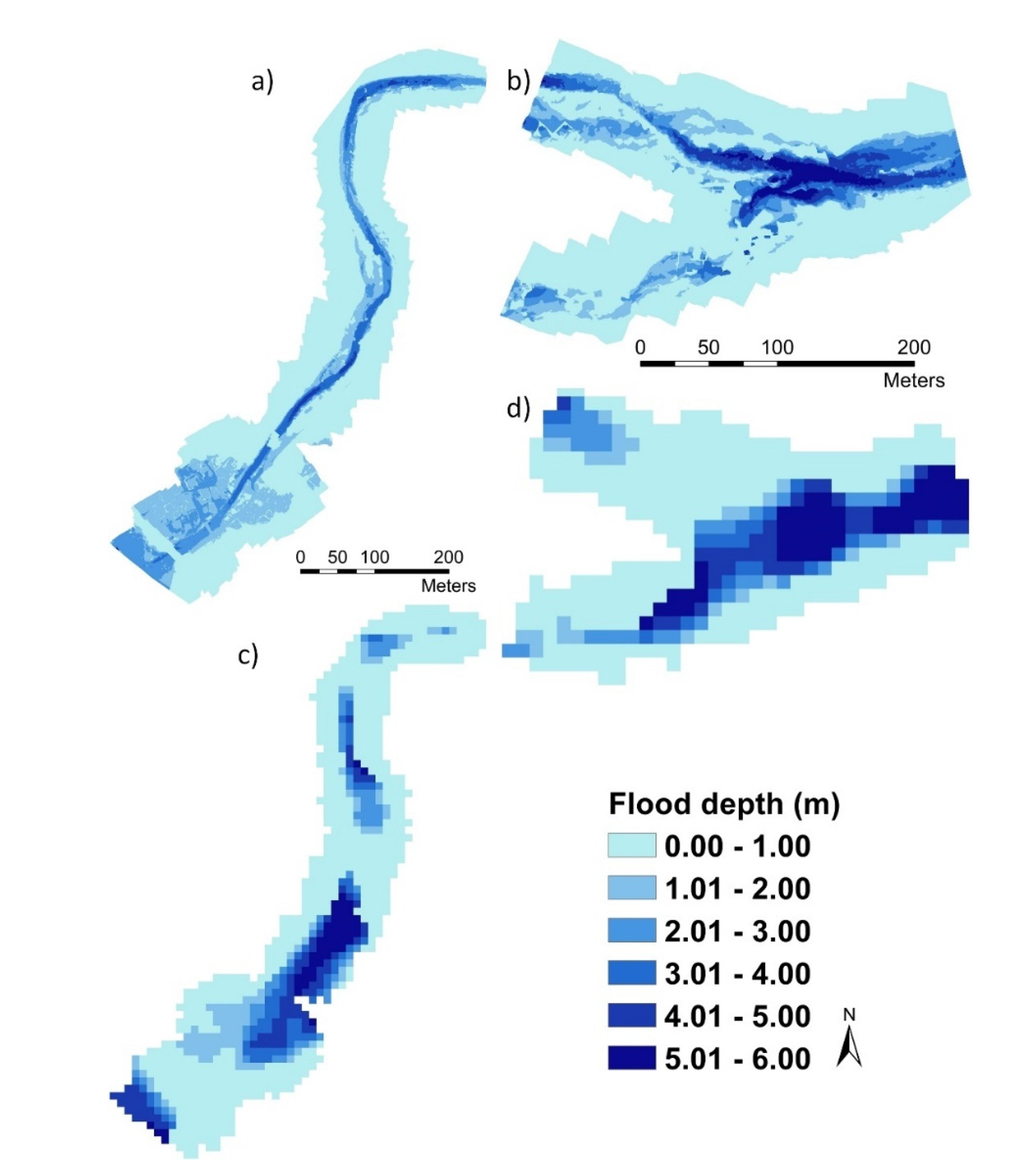

| Item | Million USD |
|---|---|
| Damage to housing | 354 |
| Damage to roads | 182 |
| Damage to airport and seaport | 19 |
| Bridge and culvert repair | 30 |
| Excavation and reshaping of riverbeds to restore capacity for storm floods | 44.63 |
| Cleaning streets and main roads | 18.60 |
| Clearing of airport and seaport | 3 |
| Short-, medium- and long-term recovery of housing sector | 519 |
| Short-, medium- and long-term recovery of road sector | 302 |
| Short-, medium- and long-term recovery of airport and seaports | 61 |
| Methodology | Item | Coulibistrie (103 m3) | Pichelin (103 m3) | ||
|---|---|---|---|---|---|
| Deposition volume estimation | Sediment deposition (UAV-DSM-DoD = post-event UAV DSM—pre-event UAV DSM | Masked-out parts filled with Kriging | 1 | 42 | 22 |
| Masked-out parts filled with window average | 2 | 40 | 19 | ||
| Sediment deposition LiDAR-DTM-DoD = post-event LiDAR DTM—pre-event UAV DSM | Masked-out parts filled with Kriging | 3 | 21 | 11 | |
| Masked-out parts filled with window average | 4 | 20 | 9 | ||
| Verification | Sediment removal LiDAR-DSM-DoD = post-event LiDAR DTM—post-event UAV DSM | Masked-out parts filled with Kriging/window average | 5 | 17–20 | 9–11 |
| Volume of sediment dump at the shoreline | Masked-out parts filled with Kriging/window average | 6 | 28 | - | |
| Pre-event DTM made from masked-out pre-event UAV DSM filled by Kriging/window average | 3rd order trend surface minus pre-event DTM | 7 | 34–70 | 17–38 | |
| Pre-event DTM made from masked-out pre-event UAV DSM filled by LiDAR DTM | 3rd order trend surface minus pre-event DTM | 8 | 32–64 | 17–34 | |
| Pre-event ALOS PALSAR DTM | 3rd order trend surface minus pre-event DTM | 9 | 51–102 | 28–56 | |
| Pre-event SRTM DTM | 3rd order trend surface minus pre-event DTM | 10 | 72–144 | 23–39 | |
| Item | Ratio | |
|---|---|---|
| Coulibistrie | Pichelin | |
| UAV-DSM-DoD | 60% | 71% |
| LiDAR-DTM-DoD | 66% | 69% |
| LiDAR-DSM-DoD | 57% | 67% |
| Sediment dump at shoreline | 6% | - |
| Pre-event DTM made from pre-event UAV DSM for Trend interpolations | 64% | 66% |
| Item | Sources of Uncertainty | Influence |
|---|---|---|
| In situ investigation | Spatial variability of flooding/deposition level | Low |
| Misleading information provided by interviewees | Moderate | |
| Confusing between flood marks and sediments marks on building wall after sediment removal | High | |
| Timing between event and field data acquisition | High | |
| Availability of post event oblique imagery or video for determining sediment height | High | |
| Analysis of UAV and LiDAR data | Time gap between the event and data acquisition | High |
| Presence of vegetation, buildings, vehicles, etc. | High | |
| Availability of pre-event LiDAR data | Very High | |
| Analysis of trend surfaces and DTM | Quality of imagery affecting flooding boundary determination | Moderate |
| Accuracy and spatial resolution of pre-event DTM | High |
Publisher’s Note: MDPI stays neutral with regard to jurisdictional claims in published maps and institutional affiliations. |
© 2021 by the authors. Licensee MDPI, Basel, Switzerland. This article is an open access article distributed under the terms and conditions of the Creative Commons Attribution (CC BY) license (https://creativecommons.org/licenses/by/4.0/).
Share and Cite
Emtehani, S.; Jetten, V.; van Westen, C.; Shrestha, D.P. Quantifying Sediment Deposition Volume in Vegetated Areas with UAV Data. Remote Sens. 2021, 13, 2391. https://doi.org/10.3390/rs13122391
Emtehani S, Jetten V, van Westen C, Shrestha DP. Quantifying Sediment Deposition Volume in Vegetated Areas with UAV Data. Remote Sensing. 2021; 13(12):2391. https://doi.org/10.3390/rs13122391
Chicago/Turabian StyleEmtehani, Sobhan, Victor Jetten, Cees van Westen, and Dhruba Pikha Shrestha. 2021. "Quantifying Sediment Deposition Volume in Vegetated Areas with UAV Data" Remote Sensing 13, no. 12: 2391. https://doi.org/10.3390/rs13122391
APA StyleEmtehani, S., Jetten, V., van Westen, C., & Shrestha, D. P. (2021). Quantifying Sediment Deposition Volume in Vegetated Areas with UAV Data. Remote Sensing, 13(12), 2391. https://doi.org/10.3390/rs13122391









